Portrait mode on smartphones now rivals DSLR quality in several ways. You'll find depth of field simulation and intelligent edge detection that create stunning bokeh effects. Advanced algorithms offer adjustable focus points and AI-enhanced skin smoothing for flawless portraits. Low-light performance has improved dramatically, while customizable lighting styles give you creative control. Computational photography advancements push the boundaries of what's possible with a phone camera. You'll also enjoy greater post-processing flexibility, allowing you to refine your shots after capture. These features combine to produce professional-looking results that often match or exceed DSLR output for everyday situations. Dive deeper to uncover how smartphone technology is reshaping portrait photography.
Depth of Field Simulation
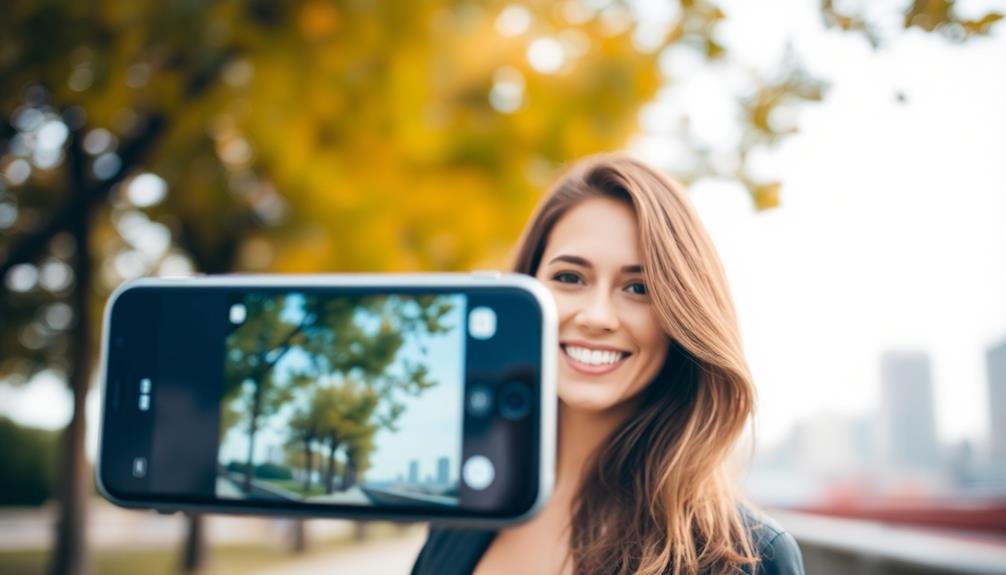
While portrait mode on smartphones attempts to simulate depth of field, it relies on software algorithms rather than optical techniques. These algorithms analyze the scene, identify the subject, and artificially blur the background to create a bokeh effect similar to what you'd achieve with a DSLR camera.
The quality of this simulation has improved dramatically in recent years. Modern smartphones use multiple lenses and advanced AI to create more accurate depth maps, resulting in smoother shifts between sharp and blurred areas. You'll notice that portrait mode can now handle complex scenes, including multiple subjects and intricate details like hair or glasses.
However, portrait mode isn't perfect. You might spot artifacts around the edges of subjects, especially in challenging lighting conditions. It can also struggle with transparent objects or complex textures.
DSLRs still have an advantage in producing a more natural, gradual bokeh effect due to their larger sensors and optical properties.
Despite these limitations, portrait mode has become increasingly sophisticated. For many everyday situations, you'll find that the depth of field simulation rivals DSLR quality, especially when viewed on small screens.
Intelligent Edge Detection
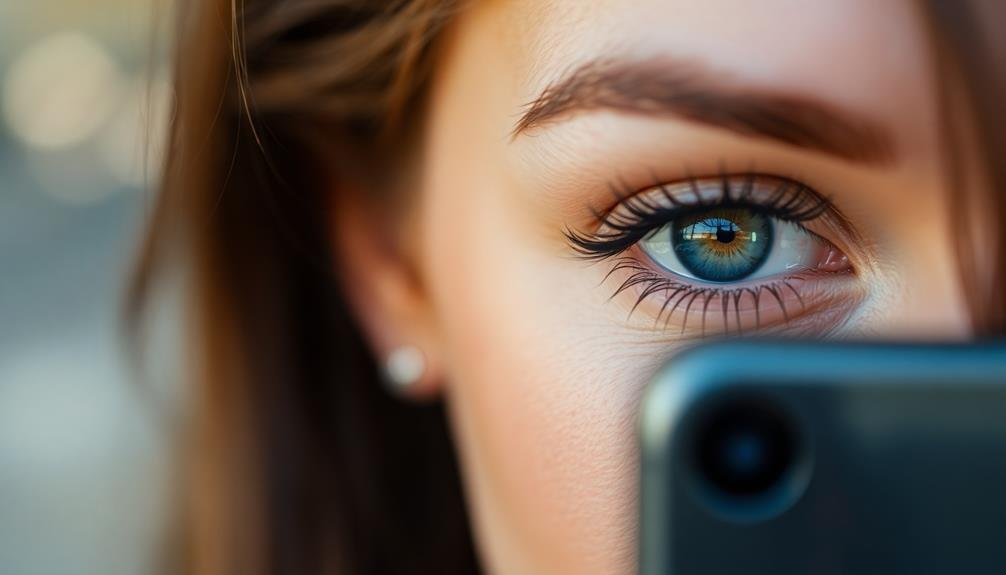
You'll notice that Portrait Mode's intelligent edge detection is a key factor in its ability to simulate DSLR-like depth of field.
This technology uses advanced software algorithms to precisely isolate the subject from the background.
Precise Subject Isolation
At the heart of Portrait Mode's effectiveness lies its ability to precisely isolate the subject from the background. This feature mimics the shallow depth of field typically achieved by DSLR cameras with wide aperture lenses.
Using advanced algorithms and depth mapping, Portrait Mode analyzes the scene in real-time, identifying the main subject and separating it from the surrounding elements.
You'll notice that Portrait Mode excels at creating a clear distinction between the foreground and background. It accurately detects the edges of your subject, including intricate details like hair strands and clothing textures. This precision allows for a natural-looking blur effect that doesn't appear artificial or overly processed.
The technology behind this subject isolation has improved remarkably over time. Modern smartphones can now handle complex scenes with multiple subjects, reflective surfaces, and challenging lighting conditions.
You'll find that Portrait Mode can effectively isolate subjects in various environments, from outdoor landscapes to dimly lit interiors. This versatility rivals the capabilities of DSLR cameras, giving you professional-looking results without the need for expensive equipment or extensive photography knowledge.
Advanced Software Algorithms
Behind the scenes of Portrait Mode's impressive subject isolation lies a complex network of advanced software algorithms. These algorithms work tirelessly to analyze your photos in real-time, identifying the subject and separating it from the background with remarkable accuracy.
At the heart of this process is intelligent edge detection. It's not just about recognizing the outline of your subject; it's about understanding the nuances of human forms, hair textures, and even accessories. The software can differentiate between a person's flyaway hair and the background, guaranteeing that every strand is accounted for in the final image.
Machine learning plays an essential role here. The algorithms have been trained on millions of images, allowing them to recognize and adapt to various scenarios. They can handle complex situations like multiple subjects, intricate backgrounds, or challenging lighting conditions.
What's more, these algorithms don't just stop at detection. They're constantly refining the blur effect, adjusting it based on depth information to create a more natural, DSLR-like bokeh.
This dynamic adjustment guarantees that your portraits maintain a professional look, rivaling those taken with high-end cameras.
Advanced Bokeh Effects
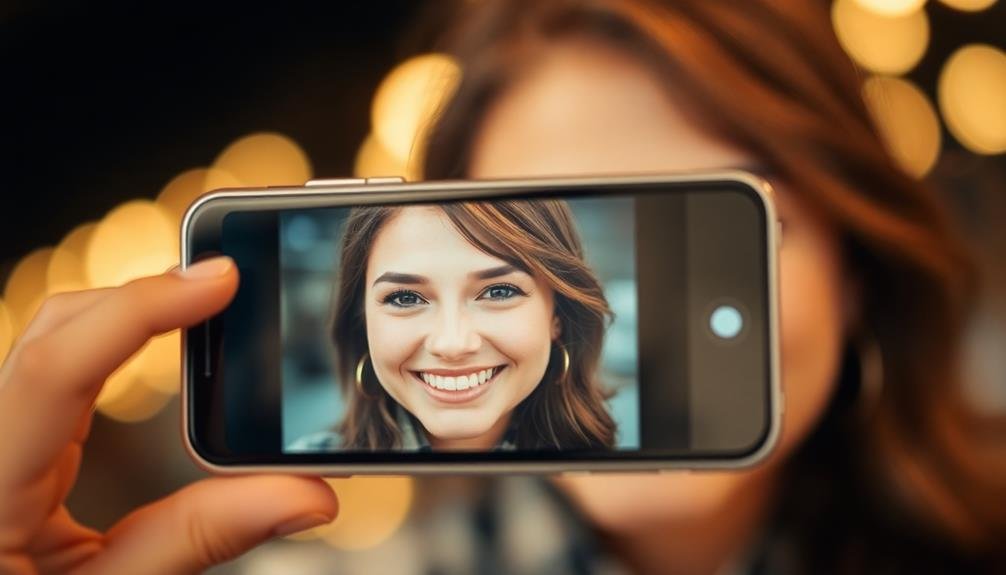
Delving into advanced bokeh effects, DSLR cameras offer unparalleled control and sophistication. However, smartphone portrait modes have made considerable strides in replicating this coveted feature. You'll find that modern smartphones can now create stunning bokeh effects that rival those of DSLRs in many situations.
Portrait mode's advanced algorithms analyze the scene and apply bokeh effects with remarkable precision. You'll notice how it carefully separates the subject from the background, creating a natural-looking blur that enhances the overall image quality. The software can even adjust the intensity of the bokeh effect, allowing you to fine-tune the look of your photos.
To fully appreciate the advanced bokeh effects in portrait mode, consider these key aspects:
- Edge detection: The software accurately identifies the subject's outline, ensuring a seamless shift between sharp and blurred areas.
- Depth mapping: Multiple camera lenses work together to create a detailed depth map, resulting in more realistic bokeh.
- Customization options: You can often adjust the bokeh intensity and style after taking the photo, giving you greater creative control.
While DSLRs still maintain an edge in certain scenarios, portrait mode's advanced bokeh effects have narrowed the gap considerably, offering impressive results in a compact, convenient package.
Adjustable Focus Points
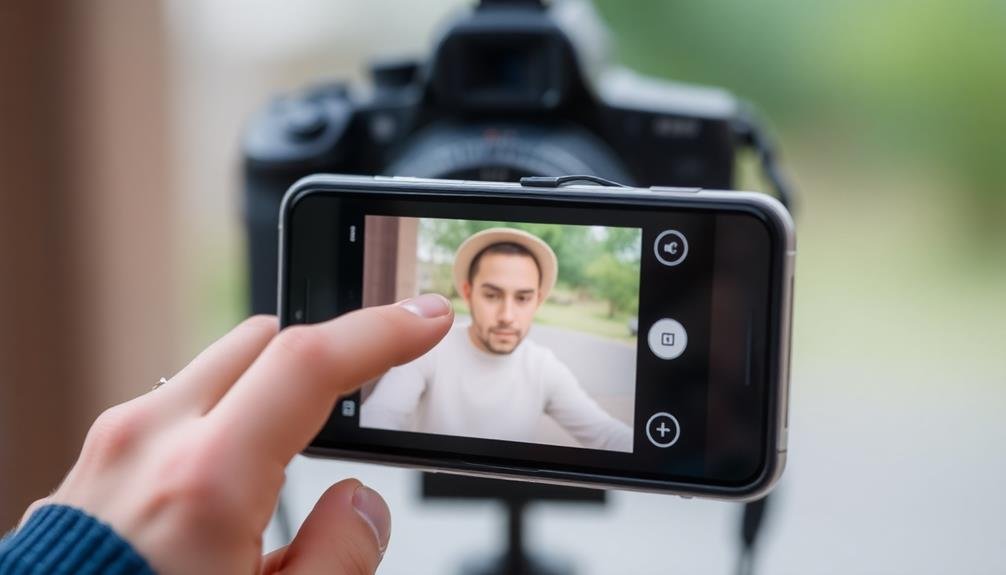
Mastering adjustable focus points can greatly enhance your photographic capabilities. With Portrait Mode, you'll find that selecting specific focus areas is now easier than ever. You can tap on your smartphone screen to choose the exact point you want in sharp focus, rivaling the precision of DSLR autofocus systems.
This feature allows you to create compelling compositions by emphasizing certain elements within your frame. Whether you're capturing portraits, landscapes, or still life, adjustable focus points give you greater control over your image's narrative. You'll be able to guide the viewer's eye to the most important parts of your photo, just as you would with a professional camera.
Here's a comparison of focus point adjustability across different camera types:
| Feature | Smartphone | DSLR | Mirrorless |
|---|---|---|---|
| Touchscreen Focus | Yes | Limited | Yes |
| Eye AF | Some models | Advanced | Advanced |
| Focus Tracking | Basic | Excellent | Excellent |
AI-Enhanced Skin Smoothing
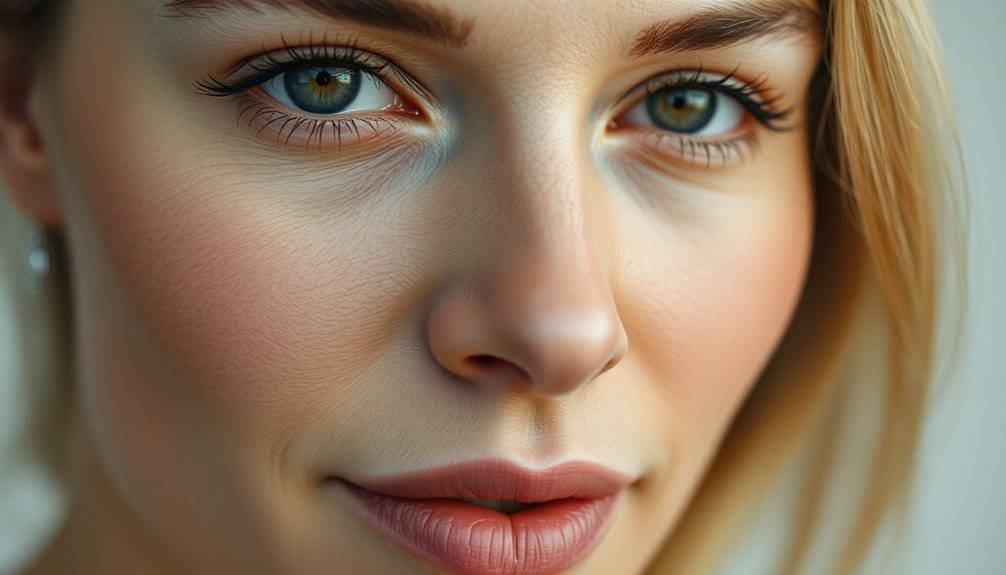
AI-enhanced skin smoothing frequently revolutionizes portrait photography on smartphones. This feature uses advanced algorithms to detect and enhance skin tones, creating a flawless appearance without the need for extensive post-processing. You'll find that this technology can rival the results of high-end DSLRs, especially when it comes to quick, share-ready portraits.
The AI analyzes facial features and applies subtle adjustments to improve skin texture while maintaining a natural look. It's capable of reducing blemishes, smoothing wrinkles, and evening out skin tone without creating an overly artificial appearance. This means you can capture stunning portraits with minimal effort, right from your smartphone.
To make the most of AI-enhanced skin smoothing:
- Experiment with different lighting conditions to see how the AI adapts
- Use it in combination with other portrait mode features for best results
- Compare the smoothed version with the original to find your preferred balance
While DSLRs offer manual control over every aspect of an image, smartphone portrait modes with AI-enhanced skin smoothing provide a quick and accessible way to achieve professional-looking results.
This technology continues to improve, narrowing the gap between smartphone and DSLR portrait quality.
HDR Integration
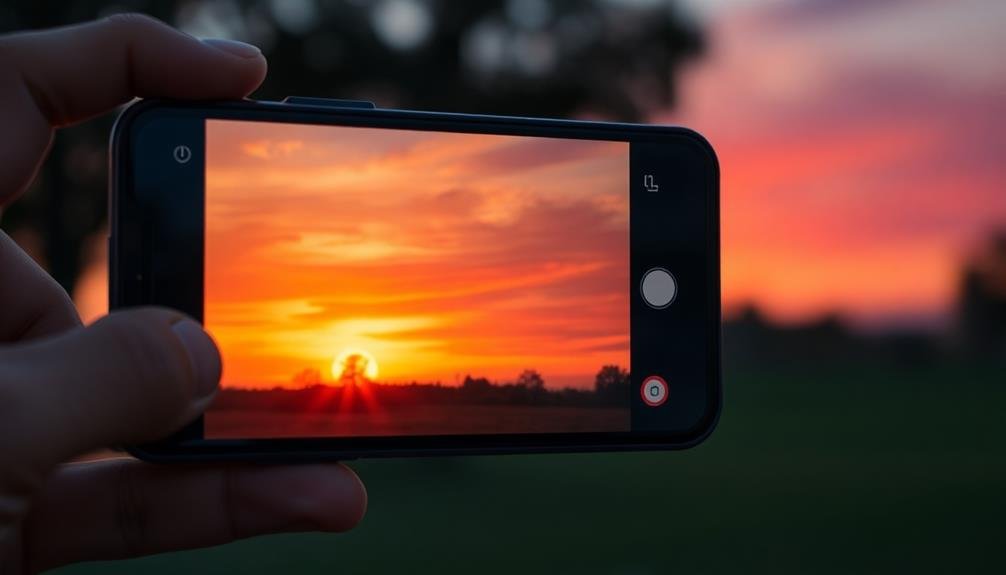
The integration of HDR (High Dynamic Range) technology in smartphone portrait modes has markedly bridged the gap between mobile and DSLR photography. When you take a portrait shot using HDR, your phone captures multiple exposures and combines them into a single image. This process allows for better detail retention in both highlights and shadows, resulting in a more balanced and professional-looking photograph.
You'll notice that HDR integration in portrait mode helps preserve the sky's color and texture while maintaining proper exposure for your subject's face. It also enhances the overall dynamic range, bringing out subtle details in darker areas without overexposing brighter parts of the image. This capability is particularly useful in challenging lighting conditions, such as backlit scenes or high-contrast environments.
Modern smartphones often use AI to optimize HDR settings, adjusting them based on the scene and subject. This intelligent approach guarantees that you get the best possible results without having to manually tweak settings.
While DSLR cameras still offer more control over HDR processing, the convenience and quality of smartphone HDR in portrait mode have made it a formidable competitor for everyday photography needs.
Low-Light Performance
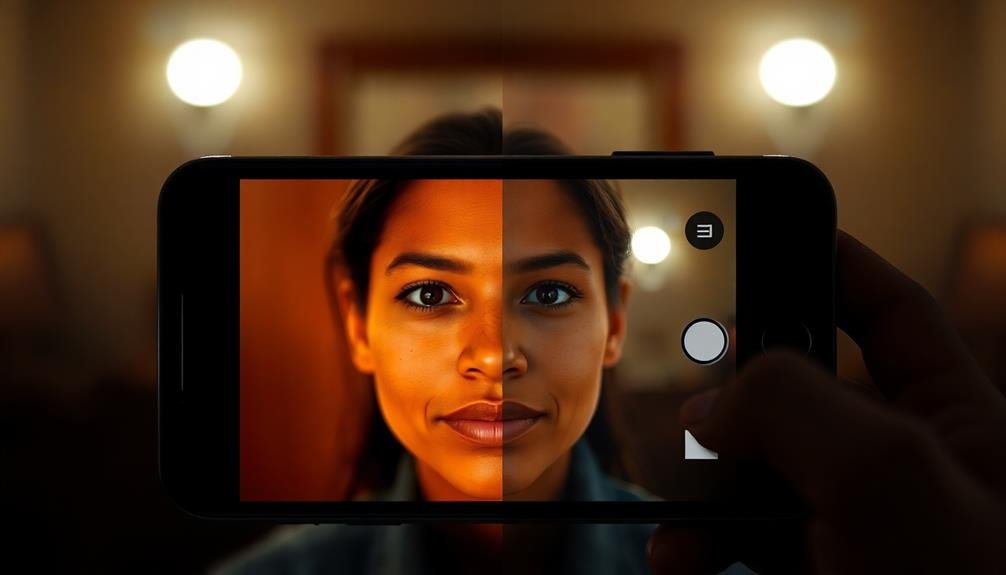
When it comes to low-light performance, smartphone portrait modes have made significant strides in recent years. The latest algorithms and hardware improvements have allowed these devices to capture stunning images in challenging lighting conditions, rivaling the quality of DSLR cameras.
You'll notice that modern smartphones employ advanced noise reduction techniques, preserving details while minimizing graininess in low-light shots. They also utilize larger sensors and wider apertures, allowing more light to reach the sensor and producing clearer, brighter images.
Portrait mode's ability to separate the subject from the background becomes even more impressive in low-light situations. The AI-powered depth mapping can still accurately detect edges and create a pleasing bokeh effect, even when lighting is less than ideal.
To make the most of your smartphone's low-light portrait capabilities:
- Use available light sources creatively to highlight your subject
- Experiment with the night mode feature for extremely dark environments
- Keep your device steady or use a tripod for sharper results
While DSLRs still have an edge in some low-light scenarios, the gap is closing rapidly. You can now confidently capture professional-looking portraits in various lighting conditions using just your smartphone.
Customizable Lighting Styles
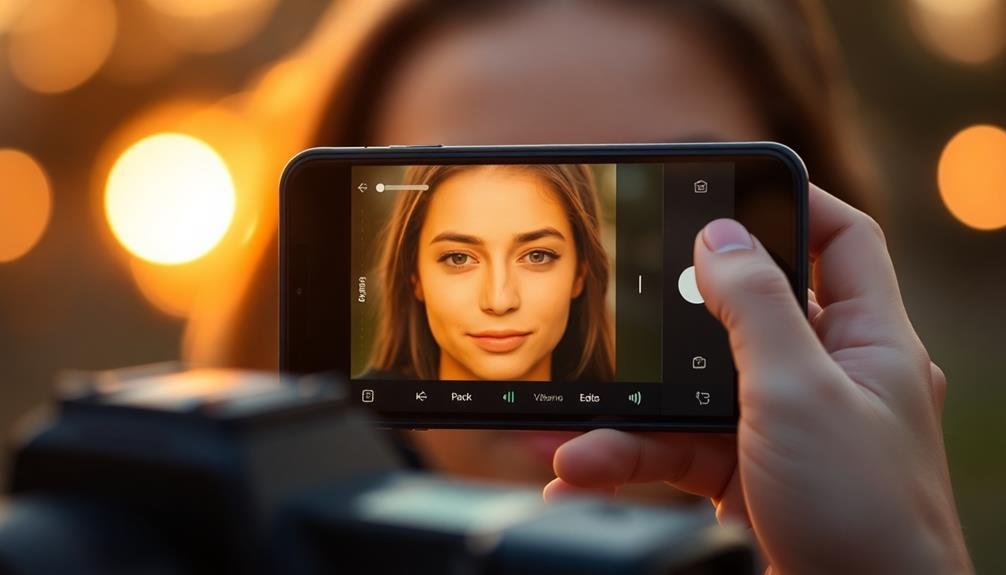
Portrait Mode's customizable lighting styles bring studio-quality effects to your fingertips.
You'll find options to adjust light intensity, creating the perfect ambiance for your subject.
With precise control over dramatic shadows, you can sculpt the mood and depth of your portraits, rivaling professional DSLR setups.
Studio-Quality Lighting Effects
Diving into the world of studio-quality lighting effects, smartphone portrait modes now offer customizable lighting styles that rival professional setups.
You'll find an array of options to enhance your portraits, from soft, diffused lighting to dramatic, high-contrast effects. These built-in tools allow you to experiment with various lighting scenarios without the need for expensive studio equipment.
With portrait mode's advanced algorithms, you can adjust the intensity, direction, and color temperature of virtual light sources. This level of control enables you to create professional-looking images that were once only possible with DSLR cameras and complex lighting rigs.
You can even simulate the look of natural window light or the warm glow of golden hour, all with a few taps on your screen.
To make the most of these studio-quality lighting effects:
- Experiment with different lighting styles to find the one that best complements your subject
- Adjust the intensity and direction of virtual light sources to create depth and dimension
- Combine multiple lighting effects to achieve a more sophisticated, multi-dimensional look
These advanced features bring studio-quality lighting to your fingertips, allowing you to capture stunning portraits that rival those taken with professional equipment.
Adjust Light Intensity
Building on the concept of studio-quality lighting effects, the ability to adjust light intensity takes portrait mode to the next level. You're no longer limited to preset lighting options; instead, you can fine-tune the illumination to achieve your desired look.
This feature allows you to control the strength and direction of virtual light sources, mimicking the precision of studio lighting setups.
With adjustable light intensity, you can create dramatic shadows or soften harsh contrasts. You'll have the power to highlight specific facial features or add depth to your subject's skin tone. This level of control rivals what you'd expect from a DSLR setup, but it's available right in your smartphone.
You can experiment with different lighting styles, from soft and flattering to bold and edgy. The ability to adjust light intensity also helps you compensate for challenging lighting conditions in real-world environments.
Whether you're shooting in bright sunlight or dimly lit interiors, you can optimize the lighting to produce professional-looking portraits. This feature empowers you to achieve consistent results across various shooting scenarios, bringing DSLR-like versatility to your smartphone photography.
Dramatic Shadows Control
While adjusting light intensity offers broad control over illumination, dramatic shadow control takes portrait mode customization to new heights. You can now sculpt the shadows in your portraits with precision, rivaling the capabilities of professional studio lighting setups. This feature allows you to emphasize facial contours, create moody atmospheres, or add depth to your images.
With dramatic shadow control, you'll have the power to:
- Adjust shadow depth and intensity independently from highlights
- Create directional lighting effects by manipulating shadow placement
- Fine-tune the shift between light and dark areas for a more natural look
You can experiment with various shadow styles to achieve different moods and aesthetics. Soft, diffused shadows create a gentle, flattering look, while sharp, high-contrast shadows add drama and intensity.
By combining shadow control with other portrait mode features, you'll be able to produce stunning, professional-looking portraits that rival those taken with high-end DSLR cameras.
Don't be afraid to push the boundaries of shadow manipulation. With practice, you'll develop an intuitive understanding of how shadows affect the overall composition and emotional impact of your portraits.
Computational Photography Advancements
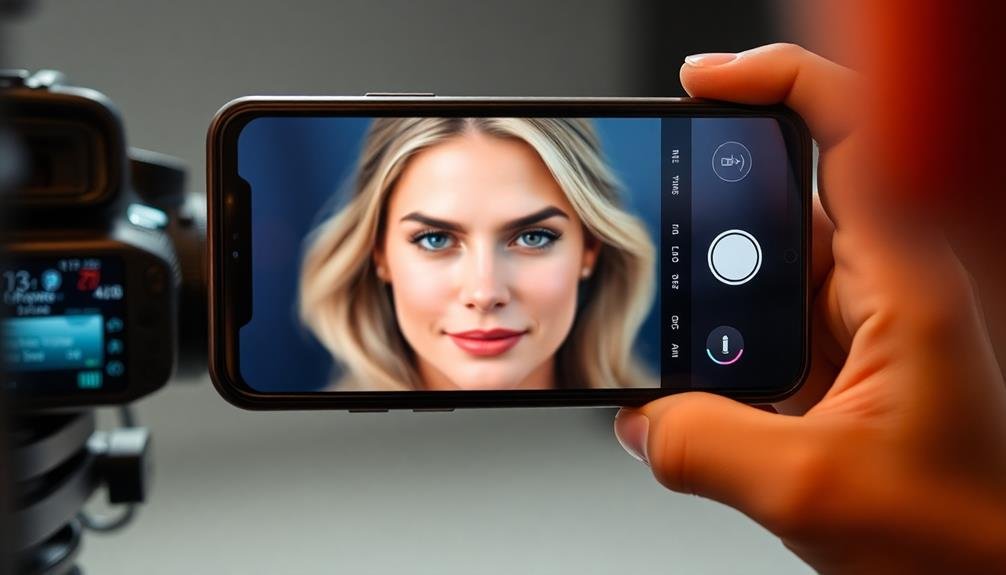
Three key advancements in computational photography have revolutionized smartphone cameras in recent years. These innovations have considerably narrowed the gap between portrait mode and DSLR quality.
First, machine learning algorithms now analyze scenes in real-time, identifying subjects and optimizing settings accordingly. You'll notice improved focus, exposure, and color balance without manual adjustments. Second, multi-frame capture combines multiple shots instantly, reducing noise and enhancing dynamic range. This technique mimics the results of longer exposures on DSLRs. Third, depth mapping has become more sophisticated, creating more accurate bokeh effects that rival those of high-end lenses.
Here's a comparison of computational photography features:
| Feature | Portrait Mode | DSLR |
|---|---|---|
| Depth Mapping | AI-powered | Optical |
| HDR Processing | Automatic | Manual/Semi-auto |
| Noise Reduction | Multi-frame | Sensor-based |
These advancements mean you can now achieve professional-looking portraits with just your smartphone. While DSLRs still have advantages in certain scenarios, computational photography has made high-quality imaging more accessible than ever. You'll find that portrait mode can often produce results that are indistinguishable from DSLR shots, especially in everyday photography situations.
Post-Processing Flexibility
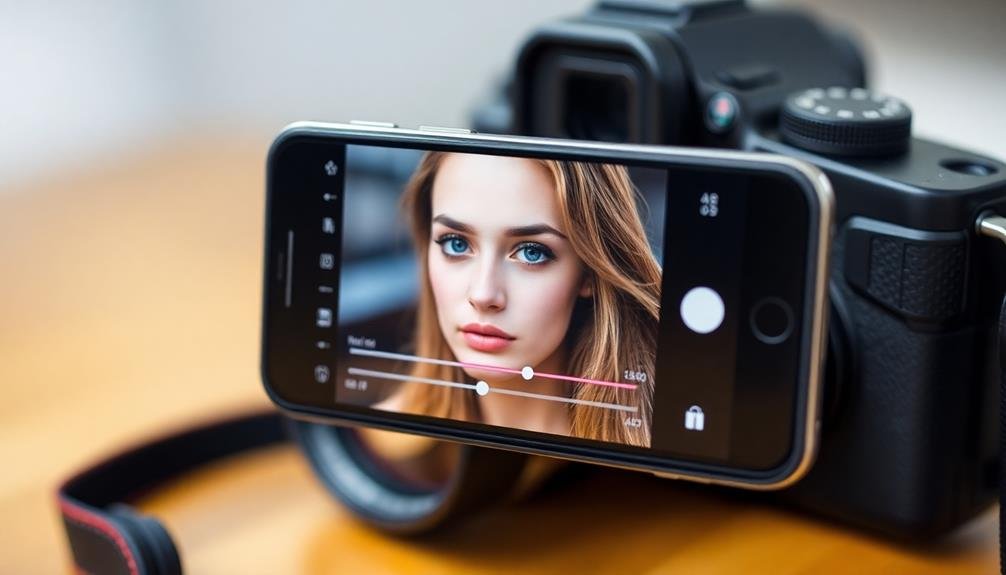
How does post-processing flexibility differ between portrait mode and DSLR photography?
While DSLRs have traditionally offered more control over image editing, smartphone portrait modes are rapidly catching up. You'll find that both methods now provide extensive post-processing options, but with different approaches.
DSLR images, shot in RAW format, give you maximum flexibility in adjusting exposure, color, and detail.
However, portrait mode photos leverage computational photography to offer unique editing capabilities:
- Depth map adjustments: You can refine the bokeh effect after taking the shot, tweaking the focus area and blur intensity.
- Lighting modifications: Many portrait modes allow you to change lighting styles or intensities post-capture, simulating studio setups.
- AI-powered enhancements: Smartphones often include one-tap edits that use machine learning to improve skin tones, facial features, and overall image quality.
While DSLRs still maintain an edge in overall editing latitude, portrait mode's targeted approach can save you time and effort.
You'll find that for many situations, the convenience and speed of smartphone editing tools can rival the results of more complex DSLR post-processing workflows.
Frequently Asked Questions
Can Portrait Mode Be Used for Non-Human Subjects?
Yes, you can use portrait mode for non-human subjects. It's great for pets, flowers, and still life objects. You'll get a similar depth-of-field effect, blurring the background to make your subject stand out beautifully.
How Does Portrait Mode Affect Battery Life Compared to Regular Photos?
You'll notice that portrait mode consumes more battery than regular photos. It's using advanced software and multiple camera lenses, which requires extra processing power. However, the difference isn't dramatic for occasional use on a fully charged device.
Are Portrait Mode Photos Larger in File Size Than Standard Images?
You'll typically find portrait mode photos are larger than standard images. They capture depth information and multiple exposures, resulting in bigger file sizes. However, the exact difference can vary depending on your specific device and settings.
Can Portrait Mode Be Applied to Existing Photos Taken Without It?
You can't apply portrait mode to existing photos taken without it. Portrait mode requires depth information captured at the time of shooting. However, you might be able to simulate the effect using photo editing software.
Does Portrait Mode Work Equally Well on Front and Rear Cameras?
You'll find portrait mode usually works better on rear cameras due to their superior hardware. However, many newer phones offer improved front-facing portrait modes. You'll still get nice results, but rear cameras typically provide higher quality bokeh effects.
In Summary
You've seen how portrait mode has come a long way in rivaling DSLR quality. It's not just about blurring backgrounds anymore. With AI-driven enhancements, customizable lighting, and powerful post-processing options, you're now equipped to create stunning portraits right from your smartphone. While DSLRs still have their place, you'll find that portrait mode offers convenience and impressive results. As technology advances, the gap between smartphone and DSLR photography continues to narrow, giving you more creative freedom than ever before.





Leave a Reply